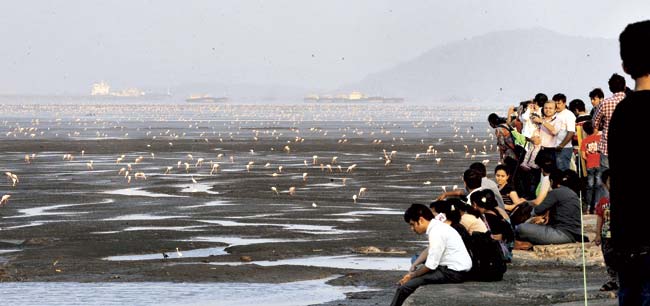A new BNHS report claims unsustainable development has threatened 10 Important Bird and Biodiversity Areas (IBAs) across India

One cannot stress enough the need for sensitivity toward animals and birds in a city which comes up with one development plan after another which often endangers biodiversity.
ADVERTISEMENT

Bird watchers watch flamingos at the Sewri-Mahul creek, one of the endangered Important Bird and Biodiversity Areas in Mumbai. File photo
Now, a Bombay Natural History Society (BNHS) report highlights that various species and habitats across India are increasingly threatened due to unsustainable developmental practices and at least 10 Important Bird and Biodiversity Areas (IBAs) are in serious danger of being lost forever.
Urbanisation to blame
BNHS has been working with UK-based Birdlife International, a conservation organisation, and provides data on IBAs from India and partners in research and conservation projects.
In their latest research, titled IBAs in Danger, the reasons found for the loss of IBAs include destruction/disturbance due to infrastructure development, industrial and sewage pollution and rapid urbanisation. Conservation of IBAs, noted the research, will directly help in tackling problems such as habitat loss, ensuring sustainable resource use and controlling climate change.
Raju Kasambe, project manager of the IBA Programme, BNHS, said, "Unfortunately in India, nearly 50 per cent of the IBAs do not have official recognition from the government. These areas need utmost and urgent protection if we are serious about saving threatened bird species. Our future generations will not pardon us for destroying important habitats of birds so callously.”
Most threatened habitats
BNHS studies reveal that the IBAs such as the Great Indian Bustard Sanctuary in Solapur/Ahmednagar, Sewri-Mahul Creek in Mumbai, the Flamingo City in Kachchh, Sailana Kharmor Sanctuary in Ratlam, Tillangchong in Andaman-Nicobar, Dihaila Jheel in Shivpuri, Karera Wildlife Sanctuary in Shivpuri, Basai in Gurgaon, Sardarpur Florican Sanctuary in Dhar and Ranebennur in Haveri are among the most threatened habitats in the country.
These areas cover habitats such as coastal and inland wetlands, grasslands and forests, which are at the greatest risk of losing their key biodiversity. Most of these IBAs also provide water supply for drinking and agriculture, tourism potential and natural pest control, if managed sustainably.
Melanie Heath, BirdLife’s Director of Science, Policy and Information said, “We must work collectively to mitigate these threats, strengthen the implementation of laws, ensure that environmental safeguards are implemented at the earliest stages of development, and enhance the management of these sites.”
 Subscribe today by clicking the link and stay updated with the latest news!" Click here!
Subscribe today by clicking the link and stay updated with the latest news!" Click here!






